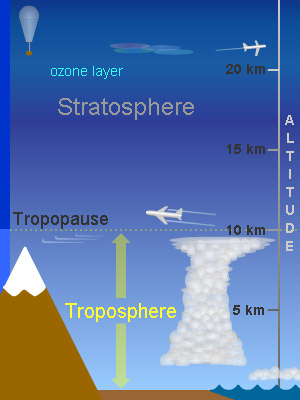Click on image for full size
Original artwork by Windows to the Universe staff (Randy Russell).
Related links:
MILAGRO Campaign - studying air pollution around Mexico City
Movie showing when gases will rise and mix and when they won't
Tropospheric Ozone, The Polluter content and activities from Project LEARN
The Troposphere
The troposphere is the lowest layer of Earth's atmosphere. The troposphere starts at Earth's surface and goes up to a height of 7 to 20 km (4 to 12 miles, or 23,000 to 65,000 feet) above sea level. Most of the mass (about 75-80%) of the atmosphere is in the troposphere. Almost all weather occurs within this layer. Air is warmest at the bottom of the troposphere near ground level. Higher up it gets colder. Air pressure and the density of the air are also less at high altitudes. The layer above the troposphere is called the stratosphere.
Nearly all of the water vapor and dust particles in the atmosphere are in the troposphere. That is why most clouds are found in this lowest layer, too. The bottom of the troposphere, right next to the surface of Earth, is called the "boundary layer". In places where Earth's surface is "bumpy" (mountains, forests) winds in the boundary layer are all jumbled up. In smooth places (over water or ice) the winds are smoother. The winds above the boundary layer aren't affected by the surface much.
The troposphere is heated from below. Sunlight warms the ground or ocean, which in turn radiates the heat into the air right above it. This warm air tends to rise. That keeps the air in the troposphere "stirred up". The top of the troposphere is quite cold. The temperature there is around -55° C (-64° F)! Air also gets 'thinner' as you go higher up. That's why mountain climbers sometimes need bottled oxygen to breathe.
The boundary between the top of the troposphere and the stratosphere (the layer above it) is called the tropopause. The height of the tropopause depends on latitude, season, and whether it is day or night. Near the equator, the tropopause is about 20 km (12 miles or 65,000 feet) above sea level. In winter near the poles the tropopause is much lower. It is about 7 km (4 miles or 23,000 feet) high. The jet stream is just below the tropopause. This "river of air" zooms along at 400 km/hr (250 mph)!















